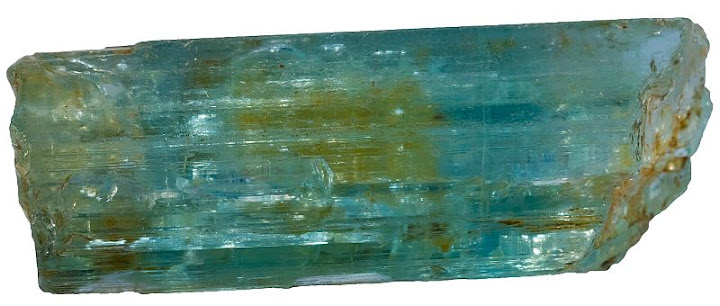Beryl is a mineral that usually occurs in granitic pegmatites. It is rare enough and occurs often as beautiful crystals. So, it should come as no surprise that it is a valued gemstone. It is most commonly named by gemologists either emerald (deep green), aquamarine (light blue) or morganite (pink).

A crystal of aquamarine. Width of sample 5 cm.
Beryl (Al2Be3Si6O18) is a silicate mineral like most other crust-forming minerals. What makes it special is a chemical element beryllium. There are about 3…6 ppm (parts per million) of Be in the crust. Beryl is the most important of Be-bearing minerals. There are actually only few noteworthy minerals that contain this element. Therefore, beryl is not only important as a gemstone but also as a source of Be.
Beryllium ion is so small (its atomic number is 4) that most minerals can not find use for it. So, it gets concentrated in residual magmatic fluids and becomes part of a special mineral tailored for it. It is beryl which is therefore most commonly found in pegmatites and hydrothermal veins.
The color of this mineral is variable. Soft hues of blue, green and yellow occur most commonly. Crystals have a vitreous luster. Apatite crystals may be similar. They also occur in hexagonal prismatic crystals and have a variable color but apatite is significantly softer (hardnesses 5 and almost 8 for apatite and beryl, respectively, in the Mohs scale). This mineral is commonly associated with quartz, K-feldspar, micas, tourmaline, and other minerals that may occur in granitic pegmatites. Sometimes it occurs in granite or syenite (this rock is similar to granite but contains very little quartz or not at all). Some metamorphic rocks may also contain it. Emerald, which is the most valued type of beryl, occurs usually in metamorphosed carbonate rocks.
Nice beryl photos!